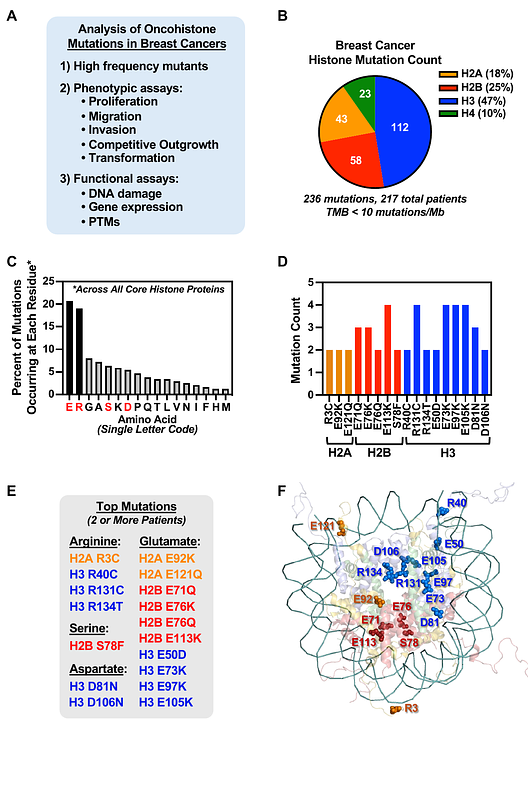Phenotypic and Functional Characterization of Oncohistone Mutations in Breast Cancers

Phenotypic and Functional Characterization of Oncohistone Mutations in Breast Cancers
Edwards, A. D.; Dai, Y.; Singh, S.; Thornton, M.; Nandu, T.; Kittler, R.; Camacho, C. V.; Huang, D.; Kraus, W. L.
AbstractAlthough mutations in genes encoding histones display a similar prevalence to that of some other somatic mutations in cancer, the underlying mechanisms by which histone mutations drive tumorigenesis have not been fully explored. Herein, we curated missense mutations occurring in core histone genes in breast cancers using data from MSK-IMPACT and cBioPortal to identify high frequency breast cancer-associated histone gene mutations. We characterized 17 high frequency oncohistone mutations in H2A H2B, and H3 that are enriched in breast cancer samples and occurred at glutamate (E), aspartate (D), serine (S), and arginine (R) residues. Many of these mutants co-occur with PIK3CA mutations in breast cancer samples. The oncohistone mutants were expressed in MCF-7 breast cancer cells or MCF-10A mammary epithelial cells and screened for effects on oncogenic phenotypes in a variety of cell- and tumor-based assays (i.e., proliferation, migration, invasion, competitive outgrowth, transformation). In addition, we examined the effects of selected mutants on DNA damage and gene expression. Our results indicate that the collection of oncohistone mutants that we screened have varying phenotypic and functional effects. Some can promote cancer-related phenotypes, with H2B-E76Q, H3-E97K, and H3-E105K eliciting strong oncogenic phenotypes and alterations in gene expression. All three of these mutants showed cooperativity with an activating mutation in PIK3CA (E545K), or a chemical activator of PI3K (UCL-TRO-1938), in assays of MCF-10A proliferation. H3-E105K also strongly promoted transformation of MCF-10A cells in an assay of growth on low attachment substrate independently of PIK3CA. Our results indicate that some high frequency oncohistone mutants can have oncogenic activity in breast cancers, and may act as potential cancer drivers. Collectively, these observations presented here can be used as a resource to connect biological and molecular outcomes to oncohistones in breast cancers.